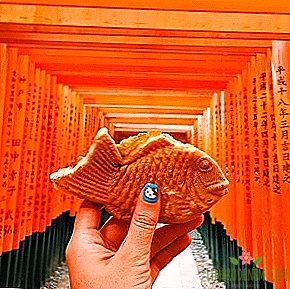From the village of foxes to the beach of pigs: The places that captured animals

Alexandra Savina
It's hard to believe, but there are still places on earthwhere animals are much bigger than people. Some of them were created artificially to protect animals, and somewhere animals occupied the territory on their own. We talk about the island inhabited by rabbits, the temple with rats, the beach owned by pigs, and other places where you can get to know our smaller brothers better.
Fox Village in Miyagi Prefecture
Fox "village" Zao was founded in 1990. The reserve is located near the Japanese city of Shiroishi, there are more than a hundred animals here: foxes of six different species (mostly red, although there are, for example, black-brown), as well as other animals - rabbits and goats. Many of them are not afraid to approach people, so that visitors can, if they wish, feed them with special food. In general, it is worth to be on the lookout: foxes strive to drag off anything that lies badly and to chew on visitors' bags. In addition, the administration of the reserve warns that animals can bite (albeit extremely rarely) - so be careful if you are going to go there with the children.
Big Major Reef where pigs live
The beach of the desert reef Big Major, belonging to the Bahamas, called "pig". About two dozen feral domestic pigs live here, who are not at all afraid of people and may even jump into the boat for tourists. There are different versions of how the pigs ended up on the island: some say that the animals reached the coast after a shipwreck, others said that the sailors sailing here, who wanted to return after them and eat them. Fortunately, now no one thinks to bite them: travelers have chosen the island now - for example, last year Amy Schumer came here.
Cat Islands in Japan
In Japan, there are several islands, where there are more cats than people. The most famous among them are Aoshima, where there are six cats for each inhabitant, and Tashiro. In the past, fishermen started cats on islands to kill mice that fed on silkworms (silk was necessary for making fishing nets), and allowed them to breed freely. In the fifties of the last century there were about a thousand inhabitants in Tashiro, and now there are about a hundred of them left, so the main population of the island is cats. Residents of Tashiro are forbidden to have dogs, and the island is periodically visited by a veterinarian to make sure that the animals are healthy and satisfied with everything.
Penguins in the Falkland Islands
On the Falkland Islands, there are only about three thousand people - but about a million penguins of five different species live here. The birds had a hard time for many years: three hundred years ago there were about ten million, but they were seriously affected by the production of whale oil, and then due to the Falklands war between Britain and Argentina and fish production on the island - the penguins didn’t have enough food for a decade their population fell from six million to one.
At the same time, the Falklands War helped the birds in an unusual way. During the war, Argentine troops laid mines on the coasts and pastures, not far from the capital of the islands. From mines (now there are about twenty thousand on the islands), not a single person has been injured, but the fenced area has become almost a reserve for penguins: because of their low weight, birds can safely walk on the ground without being blown up by mines where they cannot walk people.
Rabbit Island Okunoshima
Japan is famous not only for cat settlements, but also for the island of rabbits. On Okunosima lives a lot of wild rabbits, which are not afraid of people at all and willingly approach tourists. As to why there are so many of these animals on the island, there are several theories. The main one is very gloomy: in 1929-1946, the Japanese army secretly tested chemical weapons on Okunosima (there are still abandoned bases on the island) - the island was chosen because of its good location, since it was far from civilians. Rabbits were brought to the island to check the effects of poisonous gases on them. Another theory is more peaceful: according to it, in the 70s of the last century schoolchildren brought eight rabbits to the island - they multiplied until their population reached unprecedented scales.
Elephant Seals in California
The easiest way to see elephant seals close by is to visit the Anjo-Nuevo Reserve in California: animals swim to the shore to mate and thousands of cubs are born here every year. Security requirements prohibit approaching elephants closer than seven meters - but they already look impressive: males can reach four meters in length and weigh about two tons. In the mating season, from December 15 to March 31, you can see elephant seals only with a guided tour under the guidance of the park staff - you can see them yourself the rest of the time.
Snake Island in Brazil
Unlike other items on this list, Keimada Grande Island, located near Brazil, is not visited by tourists. It is called the "Snake Island": about four thousand snakes live here - on average, one for every five square meters. These are extremely poisonous island botropses - this species of snake is responsible for 90% of deaths from snake bites in Brazil (won’t be surprised if they all occur on Keymada Grande). Snakes feed on migratory birds, which briefly stop on the island to rest. Authorities forbid visiting Keymada-Grandi - they are definitely better off admiring from afar.
Rat temple in india
For some, the most pleasant item on this list is the Indian temple Karni Mata, where thousands of rats live. Two legends are connected with the temple: according to one of them, twenty thousand soldiers left the battlefield and hid in the temple of the Hindu holy Karni Mata - they remained alive, but turned into rats because of their cowardly act. According to another, more popular version, the stepson Karni Matsy drowned in the lake. She pleaded with the deity of death to resurrect the boy, and he agreed to reincarnate him, and then all the descendants of the male Karni Mats into rats. Now numerous descendants of Karni Mats, the Depavat family, care for animals. It is believed that the water that rats drink is holy, and those who eat the rest of their food are lucky. If one of them is accidentally killed, a silver or gold figure takes its place in the temple.
Wallaby on an Irish island
It’s hard to believe, but on the small Irish island of Lambay there are wallabies - mammals of the kangaroo family living in Australia. Wallabies appeared on the island in the middle of the last century: a rich Irish family Baring, who owned the island, tried to bring exotic animals here - but only the wallabies got accustomed. In the mid-80s, there were even more animals on the island. In the Dublin Zoo, the population of this species increased dramatically, and the park could no longer accommodate everyone. The director of the zoo was looking for a wallaby new home and turned to the Baring family - as a result, seven more animals appeared on the island. About fifty animals now live here - about ten times more than people. They, like the elephant seals, should also be approached only at your own peril and risk - unless, of course, you are a young Dad.
Horses in an abandoned city in Namibia
Kolmanskop is a sign city in Namibia located in the Namib desert. Once there mined diamonds, but now it is abandoned: the last settlers left it in the middle of the last century, when they discovered more convenient diamond deposits. Now the only inhabitants of the city and the desert next to it are the horses, which are attracted by the water source located here. How exactly horses appeared in Namibia is unknown - according to the most popular version, they were left here by the military during the First World War. Over time, the animals adapted to the desert climate and learned to live without water longer than ordinary horses.




